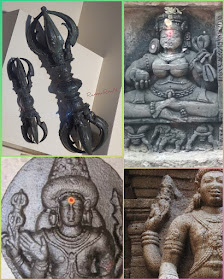Vajra or Dorje
The use of the vajra as a symbolic and ritual tool associated with Indra, and is used symbolically by the dharma traditions of Buddhism, Jainism and Hinduism spread from the Hindu religion to other religions in India and other parts of Asia.
Vajra in Buddhism:
In the tantric traditions of Buddhism, the vajra is a symbol for the nature of reality Vajrapani (lightning in hand), the special protector of Buddha Sakyamuni, being a direct loan from the Hindu God Indra. The Vajra symbolizes: indestructible, indivisible and irreducible power. Other translations were diamond or royal stone. It is an expression of the adamantine quality (diamond hardness) of the Buddha mind. The Dorje / vajra is the most important symbol of Vajrayana Buddhism. The Vajra is responsible for the name given to this stream of Buddhism, but also is the true symbol of bodhicitta or enlightenment. First it worked as a weapon of destruction and then became a precious talisman of protection. Symbolises faith, important rituals for exorcism of evil spirits. It is a common attribute of gods and lamas. In Tibetan art is shown as the attribute of various deities that hold it in one hand or near the body. It is a cosmic symbol: the cosmic pillar.
The main elements of a vajra include equal numbers of prongs on both ends, connected through a sphere or globe representing the sphere of actual reality (emptiness). The prongs (twin reflected vajras) are usually on lotus thrones, because the prongs themselves most often signify the five Wisdom Buddhas on one end and their five Mother consorts on the other.
At another level of symbolism, the two reflected ends of the vajra represent samsara and nirvana, connected by the actual reality of emptiness (sphere).
The center globe or hub represents dharmata (in Tibetan chos nyid) which is the sphere of actual reality—in other words emptiness. Whether inscribed, or visualized, the sphere contains the seed syllable (bija) of the syllable Hum.Thus it is an instrument for ritual use. The most powerful weapon of the gurus in their war against the demons, symbolised the thunderbolt of Indra.
In vajrayana Buddhism The vajara was born as an instrument of God Indra and thereafter was used for tantric rituals and exorcisms. It was the chief tool of one of the great streams of Buddhism Vajrayana.Vajra or Dorje is a conception of the electromagnetic behavior of the Sun respect the orbiting planets . In Tibet, Thailand and India vajra became a fundamental tool for religious rites of worship of Buddha.
Vajra in Hinduism :
According to the Indian mythology, vajra is considered as one of the most powerful weapons in the universe.vajra is the weapon of the Hindu rain and thunder-deity Indra. There have also been instances where the war god skantha is described as holding a vajra in south India. Indrani is the one of the personified form of Indra. Indrni is worshipped one among the sapthamatrikas in south India.
Hindu Legend on vajra :
Indra the King of the devas was once driven out of devaloka by an asura named Vritra. The asura was the recipient of a boon whereby he could not be killed by any weapon that was known till the date of his receiving the boon and additionally that no weapon made of wood or metal could harm him. Indra, who had lost all hope of recovering his kingdom was said to have approached Shiva who could not help him. Indra along with Shiva and Brahma went to seek the aid of Vishnu. Vishnu revealed to Indra that only the weapon made from the bones of the sage Dadhichi would defeat Vritra.The devas went after a long time and asked him to return their weapons so that they might defeat the asuras, headed by Vritra, once in for all. Dadhichi however told them of what he had done and informed them that their weapons were now a part of his bones. However Dadhichi realising that his bones were the only way by which the devas could defeat the asuras willingly gave his life in a pit of mystical flames he summoned with the power of his austerities. Brahma is then said to have fashioned a large number of weapons from Dadhichi's bones, including the Vajrayudha, which was fashioned from his spine. The devas are then said to have defeated the asuras using the weapons thus created.
Pic1: Vajra used in vajarayana buddhism ritual at National Museum, Jakarta, Indonesia.
Pic2: Indrani relif sculpture from Parasurameswara temple Bhubaneswar. This temple belongs to 7th century AD temple dedicated to Shiva,dated to the reign of Sailobhava dynasty - between 7th to 8th century AD. This temple has a beautiful sapthamatrikas panel. In this panel Indrani is shown in two hands in a bathamasa posture with two hands she holds vajra and kabalapathra
Pic 3: A subramaniya from Kalugumalai Vettuvan Kovil (Rock cut temple). One of the rare experimental rock cut temple of Pandya Kingdom . It is dated back to 8th CE. This Subramanian is shown in vimanam greeva region. In this sculpture Subramanian is shown with channaveeram and bathrakundalam he holds vajra and akshamala ( Rosary beads ) in his upper arms. In his lower arms he dint hold any weapons he is shown in seated position called sukhasana he folds his right leg is folded on his lap while the left foot rested over the floor
Pic4 : A Subramanian from Vaidyanadha swamy temple is located at thittakudi, near virudachalam in cuddalore district. A pllava period Subramanian relief sculpture is placed in temple passage Subramanian which belongs to 7th to 8th century AD. This Subramaniya is shown with standing posture in samabangam with chanaveram and bathrakundalam. In his upper hands he holds vajra and shathiayutha and in his lower hands he shows abaya hasta and kattihastam.
---Ramu.Rm.N







No comments:
Post a Comment